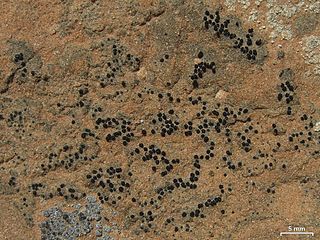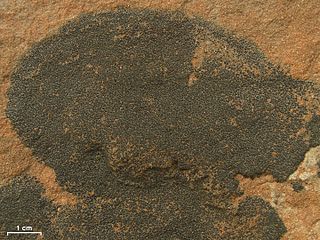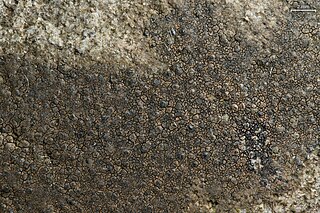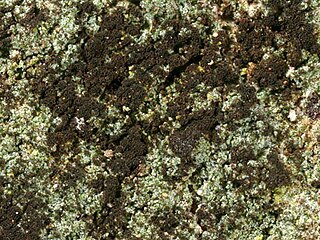
The Verrucariaceae are a family of mostly lichenised fungi in the order Verrucariales. The lichen-forming species, which comprise the vast majority of the family, have a wide variety of thallus forms, and include crustose (crust-like), foliose (bushy), and squamulose (scaly) representatives. Several characteristics of the spore-bearing structures, the ascomata, define the family, including their perithecioid form–more or less spherical or flask-shaped, with a single opening and otherwise completely enclosed by a wall. Squamulose members of the Verrucariaceae with simple ascospores, and without algae in the spore-bearing region are known as catapyrenioid lichens; there are more than 80 of these species. The family has several dozen lichenicolous (lichen-dwelling) examples, and a few genera that contain solely lichenicolous members. An unusually diverse variety of photobiont partners have been recorded, mostly green algae, but also brown algae and yellow-green algae.

Staurothele is a genus of saxicolous (rock-dwelling), crustose lichens in the family Verrucariaceae. It has about 40 species. When the fungus is part of a lichen, the genus of lichen is commonly called rock pimples.
Scleropyrenium is a genus of squamulose (scaly) lichens in the family Verrucariaceae. It has two species. The genus was circumscribed in 1993 by Japanese lichenologist Hiroshi Harada, with S. japonicum as the type species. Characteristics of the genus include a dark brown to almost black exciple, pycnidia of the Staurothele-type, and a pachydermatous upper cortex.

Phaeocalicium is a genus of lichen-forming fungi in the family Mycocaliciaceae. The genus was circumscribed in 1970 by German lichenologist Alexander Schmidt, with Phaeocalicium praecedens assigned as the type species.
Lichens of the Sierra Nevada have been little studied. A lichen is a composite organism consisting of a fungus and a photosynthetic partner growing together in a symbiotic relationship.

Staurothele areolata is blackish-brown crustose lichen in the family Verrucariaceae. It is found in western North America.

Punctelia missouriensis, commonly known as the mealy speckled shield lichen, is a species of foliose lichen in the family Parmeliaceae. It is found in the southeastern United States, where it grows on tree bark and on rocks.
Lecanora inaurata is a species of crustose lichen in the family Lecanoraceae. Found in the United States, it was described as new to science in 2016 by Caleb Morse and Douglas Ladd. The lichen occurs in open hardwood-dominated woodlands of the Edwards Plateau and grasslands of the southern Great Plains in Oklahoma and Texas. It is a member of the L. subfusca group in genus Lecanora.
Neocatapyrenium disparatum is a species of squamulose lichen in the family Verrucariaceae. Found in the United States, the lichen was described as a new species in 2005 by Othmar Breuss. It is the only member of genus Neocatapyrenium that occurs outside of Eurasia. The type specimen was collected by Clifford Wetmore in a rocky valley in Big Bend National Park, Texas, at an elevation of 6,300 ft (1,900 m); here the lichen was discovered growing on moss over soil. It is only known to occur at the type locality. The specific epithet disparatum, meaning "separated", alludes to its similarity with and separation from the lookalike species Neocatapyrenium cladonioideum.
Heteroplacidium zamenhofianum is a species of lichenicolous (lichen-eating) lichen in the family Verrucariaceae. As a juvenile, it is parasitic on some members of the lichen genus Staurothele, but later becomes independent and develops a brown, crustose thallus. Characteristic features of the lichen include its dark brown, somewhat squamulous thallus and relatively small ascospores. It is widely distributed in Europe and North America.

Willeya is a genus of saxicolous (rock-dwelling), crustose lichens in the family Verrucariaceae. It has 12 species. Most species are found in southeast Asia, although individual representatives are known from Australia, Europe, and North America.
Willeya fusca is a species of saxicolous (rock-dwelling), crustose lichen in the family Verrucariaceae. Found in Vietnam, it was formally described as a new species in 2014 by Cécile Gueidan. The species epithet fusca refers to its characteristic dark brown areolate thallus, a feature that distinguishes it from other Willeya species.
Willeya laevigata is a species of saxicolous (rock-dwelling), crustose lichen in the family Verrucariaceae. Found in northwest Vietnam, it was formally described as a new species in 2014 by Cécile Gueidan. The type specimen was found growing on shaded calcareous rock outcrops in a rainforest in the Mai Châu district of Hòa Bình province. The species epithet laevigata refers to the smooth upper surface of the thallus.
Willeya protrudens is a species of saxicolous (rock-dwelling), crustose lichen in the family Verrucariaceae. Found in northern Vietnam, it was formally described as a new species in 2014 by Cécile Gueidan. The type specimen was found growing on calcareous rock outcrops in the Na Hang Nature Reserve. The species epithet protrudens refers to the projecting perithecia, a morphological feature distinguishing it from other Willeya species.
Willeya australis is a species of saxicolous (rock-dwelling), crustose lichen in the family Verrucariaceae. Found in Indonesia, it was formally described as a new species in 1954 by Dutch lichenologist Pieter Groenhart, as Staurothele australis. He found the type specimen growing on rocks in the falls of the Brantas River. Although he included it in the genus Staurothele, he suggested that a placement in Willeya might also be appropriate. Cécile Gueidan made that generic transfer official in 2014 following molecular phylogenetic analysis of Staurothele and related genera in the Verrucariaceae.

Staurothele elenkinii is a species of saxicolous (rock-dwelling) lichen in the family Verrucariaceae. It was described as new to science by Ukrainian lichenologist Alfred Oxner in 1927, from the steppes of Ukraine. In 2013 it was recorded from the northeast Caucasus, in Russia. It is also widespread on dry rocks in the North American west, ranging from the Northwest Territories south to the southwestern United States. It grows on shales, sandstones, and calcareous rocks.
Sporodictyon is a genus of crustose lichens in the family Verrucariaceae. It has 10 species. Most species grow on rocks, although some have been recorded overgrowing soil and mosses.
Verrucaria oulankaensis is a rare species of saxicolous (rock-dwelling) crustose lichen in the family Verrucariaceae. It is found in north-eastern Finland, where it occurs on calcareous rocks on river shores.

Reichlingia is a genus of lichen-forming fungi in the family Arthoniaceae. It has seven species. The genus was originally circumscribed by Paul Diederich and Christoph Scheidegger in 1996, with Reichlingia leopoldii as the type, and at that time, only species. The fungus was at first thought to be a lichenicolous (lichen-dwelling) fungus, but is now considered a lichenised hyphomycete.
Phylloblastia fortuita is a species of foliicolous (leaf-dwelling) lichen in the family Verrucariaceae. Found in Western Europe and North America, it was formally described as a new species in 2009 by Esteve Llop and Antonio Gómez-Bolea. The type specimen was collected from Sant Medir at an altitude of 220 m (720 ft), where it was found growing on the leaves of Ilex aquifolium. The lichen, originally documented as occurring in the Mediterranean climate of the Iberian Peninsula, was reported from Marin County, California, in 2016. Other plants from which it has been documented include Buxus sempervirens, Hedera helix, Quercus ilex, and, in North America, Sequoia sempervirens.






